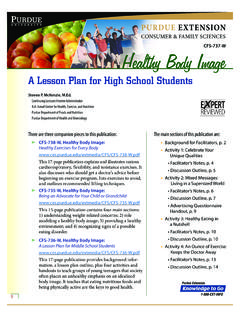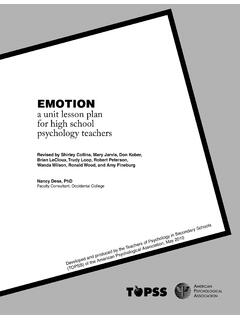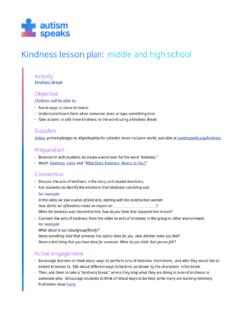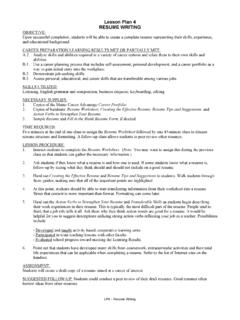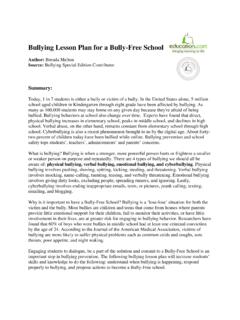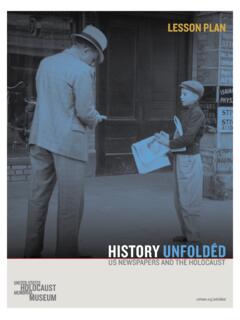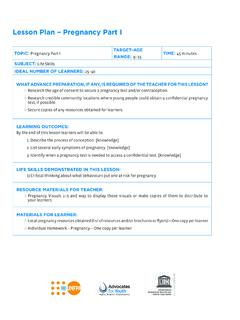Transcription of A Unit Lesson Plan for High School Psychology Teachers ...
1 SocialPsychologyA Unit LessonPlan for high School PsychologyTeachersLaura BrandtAdlai E. Stevenson high SchoolLincolnshire, IllinoisTerri LindenburgLake Park high SchoolRoselle, IllinoisReviewed and Edited by:Andrew Christopher, PhD, Albion College, Albion, MichiganEmily Leary, APA Education DirectorateDeveloped and Produced by Teachers of Psychology in Secondary Schools of the American Psychological Association, April 2007 AMERICAN PSYCHOLOGICAL ASSOCIATION 7 Contents3 Procedural Timeline6 Content Outline31 Activities80 Discussion Questions81 References83 ResourcesCopyright 2007 by the American Psychological rights part of this publication may be reproduced or distributed in any form without prior written permission of the publisher.
2 PROCEDURAL TIMELINEL esson 1. Social CognitionActivity Fundamental Attribution ErrorActivity in a Just World and Blaming the VictimLesson 2. Group ProcessesActivity 2 Deindividuated: What Would You Do? Lesson ,Competition, and ConflictActivity Versus CompetitionActivity Versus Competition: Will You Choose to Compete? Lesson 4. Attitude Formation and Change; Conformity, Obedience,and Prosocial BehaviorActivity Your Own Persuasion CampaignActivity DVDA ctivity Episode on AltruismActivity Samaritan LawsLesson Relations and PrejudiceActivity to Be Taught to Hate3 Activity Videos and the Portrayal of Men and WomenActivity and DiversityLesson 6.
3 AggressionActivity AggressionActivity and the MediaLesson 7. Interpersonal AttractionActivity Lonely Hearts ClubActivity Relationships: Studying Theories of PersonalRelationship Development This Unit Lesson plan aligns with the following Content Standards in the Variations inIndividual and Group Behavior Domain of the National Standards for high SchoolPsychology Curricula (APA, 2005) judgment and attitudesVC-2. Social and cultural categoriesVC-3. Social influence and relationshipsReferenceAmerican Psychological Association. (2005).National Standards for high SchoolPsychology , of the Content OutlineBenjamin, L.
4 , Hopkins, , & Nation, J. R. (1994). Psychology (3rd ed.). , D. (2006). Psychology (7th ed.). Boston: Houghton Mifflin , S. J., Olson, J. M., & Wiggins, E. C. (2006).Social Psychology ,CA: Thomson Wadsworth , P. (2006). Psychology (5th ed.). New York: Worth , D., & Hockenbury, S. (2005). Psychology (4th ed.).NewYork: Worth , D. (2006). Psychology (8th ed.). New York: Worth , W. (2007). Psychology : Themes and variations (7th ed.). Belmont, CA:Wadsworth Publishing/Thompson s A. Smith, PhD, of Kennesaw State University (Kennesaw, GA), HaroldTakooshian, PhD, of Fordham University (New York, NY), Stephanie Neuberger of AdlaiE.
5 Stevenson high School (Lincolnshire, IL), Carol Dean (formerly of Lake Park HighSchool, Roselle, IL), and Joyce Hylton (formerly of West Springfield high School ,Springfield, VA) helped with the development of this Lesson plan . Robin J. Hailstorks,PhD, and Steven J. Breckler, PhD, of the American Psychological Association alsoreviewed and edited this to one of the most exciting areas of Psychology to teach! Social Psychology is defined as the scientific study of how individuals thoughts, feelings, and behaviors are influenced by others (Breckler, Olson, & Wiggins, 2006). Social Psychology , more so than any other area of Psychology , allows us to understand individual behavior,group dynamics, and the social forces that shape attitudes and behaviors across timeand settings.
6 This unit Lesson plan is designed to provide you with core knowledge insocial as well are resources to invigorate your classroom experience. Each Lesson inthe unit includes core concepts, examples of each concept, activities to provoke criticalthinking, and teaching resources to supplement your lectures and the material presented in this unit Lesson plan provides the impetus for stimulating theminds of your students. It is also food for thought to assist adolescents in thinking aboutthemselves, their families, peers, community, and the world at large. This material willalso assist your students in understanding that they can change the world in which theylive.
7 It also explains the role of culture in influencing individual and group Lesson plan offers high School students numerous glances at their own behavior,thereby increasing chances of changing their attitudes and behaviors toward individualsand members of society at an immediate level, the content can help them thinkabout how they can change the culture of their schools ( , curtailing violence, helpingrejected children, minimizing aggression, etc). Students need to develop the social and cognitive skills that will assist them in navigating their world and the adult world that is are strongly encouraged to incorporate materials that stretch students mindsand encourage them to see the relationship between these concepts and their material can be used across the curriculum to heighten awareness and understand-ing regarding human , S.
8 J., Olson, J. M., and Wiggins, E. C. (2006).Social Psychology ,CA: Thomson Wadsworth OutlineLesson 1. Social CognitionI. Social Social cognitionis the study of how information about people isprocessed and stored. Our thoughts, perceptions, and beliefs about people areinfluenced by the social context in which we interact with cognition meets our needs to accurately perceive the world around us andto perceive ourselves in a positive Person schemasare mental representations that influence how we perceive are also known as influence how information is processed and how we interpretinformation. We pay more attention to people who portray characteristicsthat are consistent with our schemas or ideas about how people shouldbehave in a public We tend to listen more intently to a presentation given by aperson who is professionally dressed and who demonstrates expertise on a topic.
9 We tend to pay less attention to a presentation given by a person who is dressed nonprofessionally and who does not appear to be knowledgeable about a given Schemas influence what we remember because we attend to (see andhear) things that are consistent with our current This top-down processing helps us quickly respond to people weencounter, but it can also lead to errors in judging others that result in narrow mindedness and even We might assume that students who have learning disabilitiescannot be gifted students as well. There is an inherent tendency to viewstudents with learning disabilities as less intelligent than students who donot have learning an expectation about how a certain event or situation should Following a successful job interview, an applicant expects to receive atelephone call requesting a second interview or a job prophecyoccurs when our expectations cause us unconsciously toact in a manner to bring about behaviors that confirmour and Jacobson (1968) Teachers were told that certain elemen-tary School students would bloom (have rapid academic growth).
10 At the end6of the academic School year, the randomly chosen bloomers showed signifi-cantly greater gains in than their control-group classmates. Teacherexpectancies about the children directly influenced student performance tests (unconsciously, the Teachers tended to use a larger vocabulary withand provide more stimulation to the bloomers).2. Another example of a self-fulfilling prophecy is that Teachers who have highexpectations of their students will often have students who work diligently tolive up to those high A self-fulfilling prophecy, at the unconscious level, can influence personal The student who believes he/she cannot pass a test will not studyas hard as needed, thereby confirming that he/she was right.










